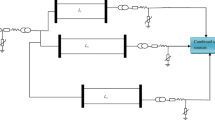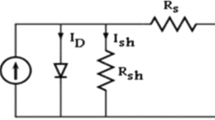Abstract
In order to minimize the power loss and to control the voltage in the power systems, the proposed momentum-based wavelet neural network and proposed momentum-based double wavelet neural network are proposed in this paper. The training data are obtained by using linear programming method by solving several abnormal conditions. The control variables considered are generator voltages and transformer taps, and the dependent variables are generator reactive powers and load bus voltages. The IEEE 14-bus system and IEEE 30-bus system are tested using the linear programming, Levenberg–Marquardt artificial neural network, proposed momentum-based wavelet neural network and proposed momentum-based double wavelet neural network to validate the effectiveness of the proposed MDWNN method. The trained neural networks are capable of controlling the voltage, and reactive power in power systems is proved by the results with the high level of precision and speed.













Similar content being viewed by others
References
Bhatele RP, Sharma JD, Thapar OD (1985) Optimal reactive power control via loss minimization and voltage control. Int J Electr Power Energy Syst 7:247–252
Badar AQH, Umre BS, Junghare AS (2012) Reactive power control using dynamic Particle Swarm Optimization for real power loss minimization. Int J Electr Power Energy Syst 41:133–136
Thukaram D, Kashyap KH (2003) Artificial neural network application to power system voltage stability improvement. In: Proceedings of IEEE international conference on convergent technologies, pp 53–57
Ganjefar S, Ahmadi A (2011) Improvement of power system transient stability using Wavelet Neural Networks and FACTS devices. In: Proceedings of IEEE international conference on power engineering and optimization, pp 17–21
Sallam AA, Khafaga AM (2002) Artificial neural network application to alleviate voltage instability problem. In: Proceedings of IEEE conference on power engineering, pp 133–141
Khaldi MR (2008) Neural networks and static voltage stability in power systems. In: Proceedings of IEEE international conference on industrial technology, pp 1–6
Mamandur KRC (1982) Emergency adjustments to var control variables to alleviate over-voltages, under-voltages, and generator var limit violations. IEEE Trans Power Appar Syst 101:1040–1047
Wagner WR, Keyhani A, Hao S, Wong TC (1990) A rule-based approach to decentralized voltage control. IEEE Trans Power Syst 5:643–651
Dopazo JF, Klitin OA, Stagg GW, Watson M (1967) An optimization technique for real and reactive power allocation. In: Proceedings of IEEE conference, pp 1877–1885
Grant L, Venayagamoorthy GK, Krost G, Bakare GA (2008) Swarm intelligence and evolutionary approaches for reactive power and voltage control. Proc IEEE Swarm Intell Symp 1:21–23
Bakare GA, Krost G, Venayagamoorthy GK, Aliyu UO (2007) Comparative application of differential evolution and particle swarm techniques to reactive power and voltage control. In: Proceedings of international conference on intelligent systems applications to power systems, pp 1–6
Krost G, Bakare GA (1999) A genetic algorithm based approach for improvement in voltage profile and real power loss minimization. In: Proceedings of international conference on electrical power engineering, pp 15–23
Mamandur KRC, Chenoweth RD (1981) Optimal control of reactive power flow for improvements in voltage profiles and for real power loss minimization. IEEE Trans Power Appar Syst 100:3185–3194
Varadarajan M, Swarup KS (2008) Network loss minimization with voltage security using differential evolution. Electr Power Syst Res 78:815–823
El-Sayed MA (1998) Artificial neural network for reactive power optimization. Neurocomputing 23:255–263
Liang R-H, Wang Y-S (2003) Fuzzy-based reactive power and voltage control in a distribution system. IEEE Trans Power Delivery 18:610–618
Dommel HW, Tinney WF (1968) Optimal power flow solutions. IEEE Trans Power Appar 10:1866–1876
Swarup KS, Subash PS (2005) Neural network approach to voltage and reactive power control in power systems. In: Proceedings of IEEE conference on intelligent sensing and information processing, pp 1–8
El-Kady MA, Bell BD, Carvatho VF, Burchett RC (1986) Assessment of real-time optimal voltage control. IEEE Trans Power Syst 1:98–105
Singh H, Srivastava L (2014) Modified differential evolution algorithm for multi-objective VAR management. Int J Electr Power Energy Syst 55:731–740
Sina A, Aeenmehr A, Mohamadian H (2012) Power system voltage control using lp and artificial neural network. World Acad Sci Eng Technol 6:560–564
Hooshmand R, Joorabian M (2005) Application of artificial neural networks in controlling voltage and reactive power. Sharif Univ Technol 12:99–108
Acknowledgments
The authors express their sincere thanks to the authorities of Anna University for providing necessary facilities to carry out this research work. The authors are grateful to University Grants Commission, New Delhi for providing the financial grant under Maulana Abul Kalam Azad Scheme to carry out this research work.
Author information
Authors and Affiliations
Corresponding author
Appendices
Appendix 1: Specification of IEEE 14-bus system
The maximum and minimum limits of control variables and dependent variables are specified in Tables 8 and 9.
Appendix 2: Specification of IEEE 30-bus system
The maximum and minimum limits of control variables and dependent variables are specified in Tables 10 and 11.
Rights and permissions
About this article
Cite this article
Deepa, S.N., Rizwana, J.B. Momentum-based wavelet and double wavelet neural networks for power system applications. Neural Comput & Applic 29, 495–511 (2018). https://doi.org/10.1007/s00521-016-2552-9
Received:
Accepted:
Published:
Issue Date:
DOI: https://doi.org/10.1007/s00521-016-2552-9




